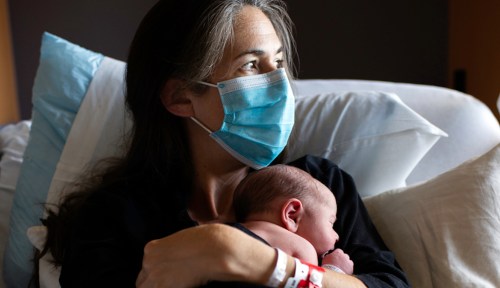Welp, the U.S. Just Got a D+ Grade for a Rising Rate of Preterm Birth, Aka Birth Before 37 Weeks—Here’s What to Know
A new report from the March of Dimes found that the preterm birth rate in the U.S. is rising, and gave a D+ grade. Here's what to know.

It’s no secret that maternal health in the U.S. isn’t the best. We currently have one of the highest maternal mortality rates in the world compared with other high-income nations. Even more alarming is that Black women are three times more likely to die from pregnancy-related complications than white women. Now there’s more bad news for pregnant people—the preterm birth rate in the U.S. is pretty bad, too. (Meaning babies born before 37 weeks of pregnancy.)
Experts in This Article
Okay, so what does the data say about the preterm birth rate in the U.S.?
The U.S. just received a D+ grade due to a rising premature birth rate from the March of Dimes annual report card on maternal and infant health. The report specifically found that the preterm birth rate in the U.S. rose to 10.5 percent last year, which was a whopping 4 percent increase since 2020. It was also the worst national rate since the organization started tracking the data in 2007.
The data show there are racial disparities at play, too: Babies born to mothers who are Black or Native American are 62 percent more likely to be born prematurely than those born to white mothers.
The report broke down the data by state and, while no one received an A grade for its preterm birth rate, Vermont was given an A- for its rate of 8 percent. Nine states and one territory received an F grade, the lowest marker available, due to high preterm birth rates, including Alabama, Arkansas, Georgia, Louisiana, Mississippi, Oklahoma, Puerto Rico, South Carolina, and West Virginia.
What exactly is going on here?
Experts say the reasons are varied, but the pandemic is part of the problem. “There are several factors that contribute to this trend but one of the largest is the fallout from COVID-19,” says women’s health expert Jennifer Wider, MD. “This is one of the more unfortunate consequences of the pandemic.”
For starters, COVID-19 infections in pregnant people can increase the risk of preterm birth, Wider says, but that’s not all. “The pandemic highlighted some pre-existing issues like access and barriers to healthcare that were only made worse during the pandemic.” She adds, “Studies showed us that these issues were particularly toughest for Black families, American Indian, and Alaskan Native families.”
There was also fear around coming to health facilities during the height of the pandemic, which prevented some expectant mothers from getting the care they needed, says Damali Campbell, MD, an OB/GYN and assistant professor at the Rutgers Robert Wood Johnson Medical School.
Another factor that could be contributing? Doctors are less inclined to use the hormone progesterone to try to prevent preterm labor in at-risk patients, since “additional evidence is not showing a clear benefit in all patients at risk for preterm labor,” says Dr. Campbell. In addition, certain risk factors like a higher maternal age, smoking, having multiples, having obesity, and spacing out births less than 18 months apart can also contribute, according to the March of Dimes.
One thing to keep in mind about these new stats, is that “preterm birth rates rise and fall slightly every year,” says Todd Rosen, MD, director of maternal-fetal medicine at the Rutgers Robert Wood Johnson Medical School. “Overall, preterm birth rates are kind of the same over the past 30 years, which is pretty awful,” he adds, especially since it is a major cause of certain serious health conditions and death in infants.
What’s the danger of having a preterm birth?
Having a preterm birth poses some challenges for the birthing person, but doctors are primarily concerned about the potential impact on the baby, says Matthew Carroll, MD, assistant professor of obstetrics and gynecology at Baylor College of Medicine.
As mentioned, babies born preterm have higher rates of major health problems, and even death, compared to those born full-term, Dr. Rosen says, adding that the leading cause of death for children up to age five in the U.S. are complications related to prematurity. “This means that more babies die because they are born preterm than from infection, birth defects, or SIDS,” he adds.
What’s being done about this?
Dr. Rosen points out that researchers have “invested a lot of time and money in research to reduce preterm birth rates.” But, he adds, “we remain pretty terrible at predicting preterm birth and preventing the majority of preterm deliveries.”
Even so, doctors are trying to do earlier assessments to determine if patients are at risk of developing preeclampsia, a potentially serious condition that causes high blood pressure in pregnancy, Dr. Campbell says.
One positive note is that the March of Dimes and the World Health Organization (WHO) have released guidance on how to help preterm babies, including providing skin-to-skin contact to preterm babies immediately after birth. But solving the actual issue of the preterm birth rate in the U.S. is a work in progress. “The National Institutes of Health, March of Dimes, and others have funded trials to prevent preterm birth and continue to do so,” Dr. Rosen says. “To date, we have not solved the problem, but we haven’t given up.”
Sign Up for Our Daily Newsletter
Get all the latest in wellness, trends, food, fitness, beauty, and more delivered right to your inbox.
Got it, you've been added to our email list.










